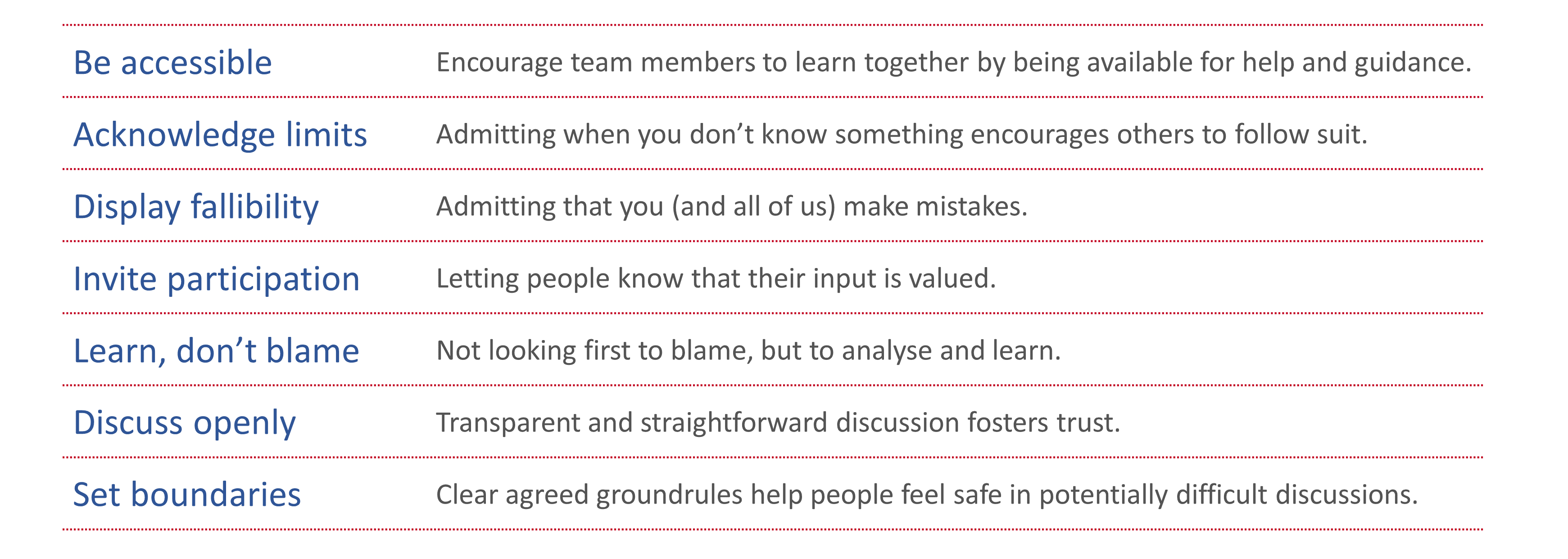Psychological Safety
-
 Overview
Overview -
 Exercises
Exercises
Overview
In practice: Creating an environment for your team and individuals that focuses on learning from mistakes rather than blame, values individual differences, and supports colleagues to feel comfortable being themselves at work.
Google’s research on its own teams1 found ‘psychological safety’ to be the most important influence on a team’s effectiveness.
In the overviews of Improving Team Dynamics and Making Decisions as a team we have seen how teams and their members thrive when members listen well to each other and speak constructively. A supportive and accepting culture is essential for fostering a sense of inclusion and collective enterprise. If team members can discuss different points of view in an open and supportive way, and one or two voices don’t drown out everyone else, the team stands a good chance of making decent decisions.
But this alone is not enough, and indeed can lead to groupthink in a team if supportiveness unwittingly results in discomfort raising and discussing more challenging topics. A successful team needs to be able to provide a sense of belonging for team members, but people must also be able to:
- Openly discuss mistakes that have been made (and we all make them!)
- Ask about things they don’t understand.
- Challenge ideas that most other team members seem to accept.
- Discuss competing and conflicting ideas without individuals feeling criticized personally.
- Raise issues that are bubbling under the surface but no individual really wants to raise for fear of unsettling the team. (see the Improving Team Dynamics page for more about overcoming un-discussability).
The team has to feel ‘psychologically safe’ enough for these more robust discussions, and the culture of the team, encouraged by the team leader, has to actively promote open discussion of anything and everything relevant to the team’s success. This is a move beyond merely being able to discuss minor differences of opinion. There is a wealth of evidence that the ability to provide this safe environment facilitates team learning, enables a team to manage pressures from its environment and provides an essential building block for team and personal resilience. To role model this for your team here are some suggestions from Amy Edmondson, Harvard Business School professor and leading expert on psychological safety 2:

Our research on over 2000 teams shows that the combination of psychological safety and constructive disagreement – allied to effective task processes and an outward-looking can-do culture - provide the biggest boosts to performance and team and personal wellbeing.
1. Rozovsky, The five keys to a successful Google team - see https://rework.withgoogle.com/blog/five-keys-to-a-successful-google-team/
2. see, for example, Edmondson, A., 2013 Teaming to Innovate, John Wiley and Sons; or Edmondson, A., 2019, The fearless organization: creating psychological safety in the workplace for learning, innovation and growth, John Wiley and Sons
Exercises
Exercise - Psychological Safety
An exercise for an individual to reflect on, or for a team to discuss:
- What factors make people in general feel comfortable / uncomfortable speaking up in a team, and
- What can be done to increase the psychological safety people feel about discussing difficult issues. Such issues could include mistakes people have made, controversial topics or challenges the team faces.
Exercise - Discussing difficult issues
An exercise to (a) review how well your team can discuss some of the typical issues that teams find challenging and (b) agree what you need to do as a team to be able to have fuller and more productive discussions in an environment of psychological safety.
Exercise - Speaking constructively
A reflective exercise to help you build good relationships and increase the psychological safety of your team by responding positively to others. An evidence based 2 x 2 box showing how people respond to another person's good news helps you identify helpful and unhelpful responses you might make and how you can build better relationships.
Exercise - Active listening
An exercise to practise Active listening with two colleagues, and receive feedback on what you did well and what you might improve.
